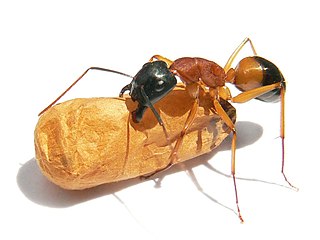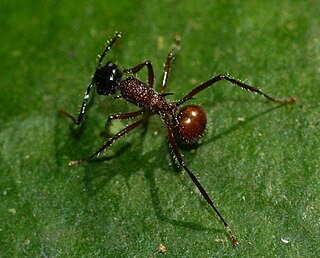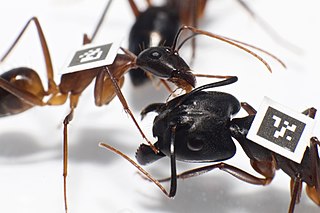
Carpenter ants are large ants indigenous to many forested parts of the world.

Colobopsis saundersi, synonym Camponotus saundersi, is a species of ant found in Malaysia and Brunei, belonging to the genus Colobopsis. A worker can explode suicidally and aggressively as an ultimate act of defense, an ability it has in common with several other species in this genus and a few other insects. The ant has an enormously enlarged mandibular (jaw) gland, many times the size of a normal ant, which produces defense adhesive secretions. According to a 2018 study, this species forms a species complex and is probably related to C. explodens, which is part of the C. cylindrica group.

The banded sugar ant, also known as the sugar ant, is a species of ant native to Australia. A member of the genus Camponotus in the subfamily Formicinae, it was described by German entomologist Wilhelm Ferdinand Erichson in 1842. Its common name refers to the ant's liking for sugar and sweet food, as well as the distinctive orange-brown band that wraps around its gaster.
Camponotus universitatis is a species of ant in the genus Camponotus, the carpenter ants. It is native to Eurasia, where it has been recorded in Spain, France, Italy, Switzerland, Albania, Bulgaria, and Turkey.

Camponotus vagus is a species of large, black, Palaearctic carpenter ant with a wide range that includes much of Europe, a large area of Asia, and part of Africa.

Polyrhachis is a genus of formicine ants found in the Old World with over 600 species. The genus is yet to be comprehensively resolved and contains many varied species including nest-weavers, swimming workers, soil and tree-dwellers.

Camponotus japonicus, commonly known as the Japanese carpenter ant, is a species of ant native to eastern Asia. It is black, and one of the largest ants. A nest has about ten to thousands of individuals, and it can be a pest when it enters households or protects aphids. There are several subspecies of this ant in different areas of Asia, with the largest of the species being located in northern China.
Camponotus bishamon is a species of carpenter ant endemic to Japan.
Camponotus reburrus is a species of carpenter ants in the subfamily Formicinae. It is known only from northeastern Ecuador. C. reburrus apparently has an obligatory relationship with the ant plants Cecropia membranacea, Cecropia herthae and Cecropia marginalis. The workers are relatively small and hairy, it does not appear to have major workers. It is similar to Camponotus balzani which also lives in Cecropia spp..

Camponotus herculeanus is a species of ant in the genus Camponotus, the carpenter ants, occurring in Northern Eurasia, from Norway to Eastern Siberia, and North America. First described as Formica herculeana by Linnaeus in 1758, the species was moved to Camponotus by Mayr in 1861.

Camponotus floridanus, or Florida carpenter ant, is a species of ant in the genus Camponotus. First described as Formica floridana by Buckley in 1866, the species was moved to Camponotus by Mayr in 1886. The ant is widespread in Florida and occurs as far north as North Carolina and as far west as Mississippi.

The black-headed sugar ant, also known as the brown sugar ant, is a species of Formicinae ant endemic to Australia. Found throughout most states, the species is a member of the genus Camponotus, a cosmopolitan genus of ants commonly known as carpenter ants. It was formally described and named by British entomologist Frederick Smith in 1858. These ants are characterised by their black head, reddish-brown mesosoma and black gaster, which can change in colour.

Niphanda fusca is a parasitic butterfly primarily found in East Asian countries such as Japan and Korea. It is a "cuckoo-type" parasite of the ant Camponotus japonicus. It utilizes chemical mimicry to trick the host worker ants into adopting it while it is a third-instar caterpillar. From there, it is fed mouth-to-mouth by the worker ants as though it were one of their own young.
Streptomyces formicae is a species of bacteria from the genus Streptomyces, which has been isolated from the ant Camponotus japonicus in Harbin in China and the ant Tetraponera penzigi in Africa. The complete genome sequence of S. formicae was published in 2017.
Streptomyces lasiicapitis is a bacterium species from the genus of Streptomyces which has been isolated from the head of the ant Lasius fuliginosus. Streptomyces lasiicapitis produces the antibiotic kanchanamycin.
Streptomyces amphotericinicus is a bacterium species from the genus of Streptomyces which has been isolated from the head of the ant Camponotus japonicus. Streptomyces amphotericinicus produces amphotericin.
Streptomyces capitiformicae is a bacterium species from the genus of Streptomyces which has been isolated from the head of the ant Camponotus japonicus. Streptomyces capitiformicae produces angucyclinone-antibiotics.

Camponotus dumetorum is a species of ant in the family Formicidae. This species belongs to the genus Camponotus, which is native to North America. They are related to other species from the subgenus Tanaemyremex in western North America such as C. semitestaceus and C. vicinus. C. dumetorum are primarily nocturnal and form undergrounds nests. Like other select ant species native to California, their populations have been displaced with the introduction of Argentine ants.

Camponotus fellah is a species of ant in the subfamily Formicinae found across the Middle East and North Africa. This species was formally described by Dalla Torre in 1893. A C. fellah queen holds the record for Israeli ant longevity, surviving for 26 years (1983-2009) in a laboratory environment.











